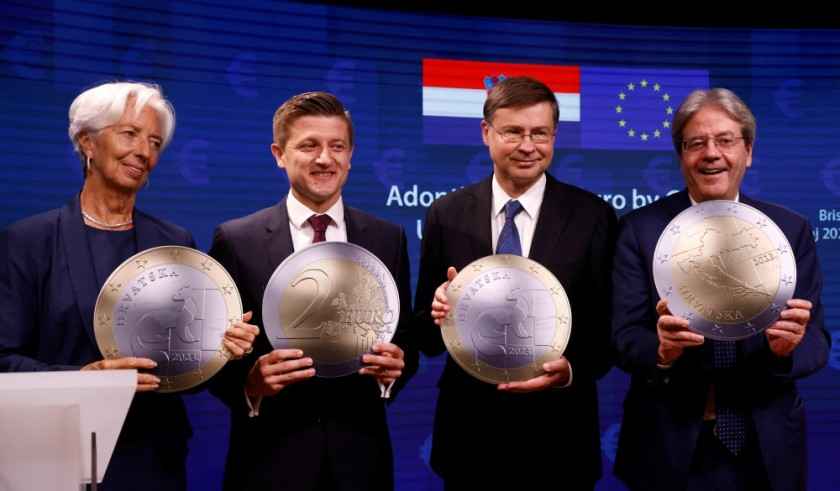
Croatia will be the 20th European country to enter the Euro zone as of January 2023, following its application to adopt Euro currency in 2013. While Euro currency has been devalued and reached equal exchange rate with US dollar for the first time since its implementation in 2002, on Tuesday 12 July 2022, the Council of the European Union approved the adoption of Euro currency for Croatia after complying with European economic conditions; maintain price stability with inflation rate at 1.5% maximum above the rate of the three best-performing member states (Croatia 4,7%), public deficit should not exceed 3% of GDP (Croatia 2,9%), public debt should not be higher than 60% of GDP (Croatia 80%), sustain currency steadiness for at least 2 years within the exchange rate mechanism (ERM III) and reach long-term interest rates (Union, Infographic – How EU countries join the euro area, 2022). The conversion rate will be set at 7,5345 HRK (Croatian Kuna) for 1 euro. (Union, 2022)
In a context of Ukraine war, Commissioner for Trade Valdis Dombrovskis stated this “Monetary Union is an asset for Europe, sign of strength, unity, and solidarity” whose Christine Lagarde, Head of European Central Bank (ECB) commented that Euro currency protects its members states. (AFP, La Croatie adhère à la zone euro en janvier 2023, 2022) The EU demonstrates its flexibility to be inclusive, especially during this tough international period.
After several international instabilities that the EU faced such as financial crisis, the migration crisis, and Brexit, Croatia adopting Euro currency is an example of European integration and reflects European Union (EU) adherence and stability to live on facing the current economic situation.
European integration which is the process of the consolidation of the EU, originates from the need to rebuild European countries after WWII demolitions, prevent war, promote long term peace and solidarity. This process basically began by each country having common economic needs and assigning its steel and coal industry to a supranational level which was first called the European Coal and Steel Community (ECSC) in 1951, the European Union predecessor. Thereafter, the EU member states, having common and different interests, progressively aim to adopt economic and political regulations by achieving compromises among the EU member states in order to be worldwide economically competitive and provide prosperity to its members states by allocating much more national competencies to the EU level, using this mechanism of European integration with a spillover effect in other sectors (cultural, social, etc.) whom Schengen area and Euro zone are some outcomes of.
This article will approach the economic integration of the EU and the below mentioned statement from Dombrovskis and Lagarde by approaching the case of Croatia taking part to the Euro currency which was created in 1999 as a monetary union by 11 European countries; Germany, France, Belgium, Italy, the Netherlands, Luxembourg, Spain, Finland, Austria, Ireland and Portugal, with the objectives of macroeconomic stabilization (inflation, deficits and currency) controlled mainly by the ECB, and regularization to build universe of standards adapted to allow optimal functioning of market and competition by respecting production rules (Foret, 2015). This regulator role enabled the EU to become the third world economy after the US and China.
While the EU rose economically by progressively achieving economic treaties and regulations, widening Euro area, welcoming new member states, and controlling economic stability, this international organization appealed to its neighbor countries (softly exporting values and norms) and the worldwide people building a legitimacy by its outcomes and lifestyle in one hand. In the other hand, vagaries such as financial crisis (2007-2008, Portugal, Spain), Greek government-debt crisis, migrations flow, Brexit, and Covid-19, which were finally addressed with the interventionist role from the EU, contributed to expose its weaknesses to tackle these new issues and respond to citizen’s expectations by progressively nurturing Euroscepticism with nationalist movement reflecting mainly in political parties at European and national level (Telo, 2016).
Considering these new challenges that the EU faced, the case of Croatia adopting Euro currency illustrates that the EU is still determined to be appealing, rising economically and continuously exercising its soft power. These international instabilities strengthened the EU and protected its member states by preventing war, promoting long term peace, solidarity, unity and thriving within its member states as Dombrovskis and Lagarde argued. The success of the EU is demonstrated by its capability of adaptation in the years and the EU will remain perennial.
References
AFP. (2022, July 12). La Croatie adhère à la zone euro en janvier 2023. Retrieved from Le Soir: https://www.lesoir.be/453744/article/2022-07-12/la-croatie-adhere-la-zone-euro-en-janvier-2023
AFP. (2022, July 12). La Croatie adhère à la zone euro en janvier 2023. Retrieved from Le Soir: https://www.lesoir.be/453744/article/2022-07-12/la-croatie-adhere-la-zone-euro-en-janvier-2023
Foret, F. (2015). De l’Etat à l’Union européenne. Brussels: Editions de l’Université de Bruxelles.
Telo, M. (2016). L’Europe en crise et le monde. Brussels: Editions de l’Université de Bruxelles.
Union, C. o. (2022, July 12). Croatia set to join the euro area on 1 January 2023: Council adopts final required legal acts. Retrieved from Council of the European Union: https://www.consilium.europa.eu/en/press/press-releases/2022/07/12/croatia-set-to-join-the-euro-area-on-1-january-2023-council-adopts-final-required-legal-acts/
Union, C. o. (2022). Infographic – How EU countries join the euro area. Retrieved from Council of the European Union: https://www.consilium.europa.eu/en/infographics/2022-06-16-joining-the-euro-area/
By The European Institute for International Law and International Relations.













